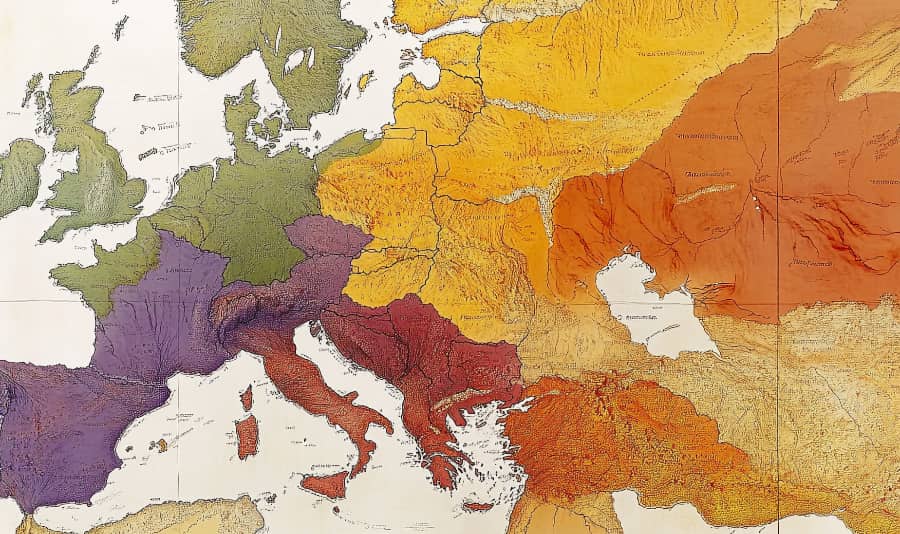Executive Summary
This analysis examines the remarkable transformation of early Christianity from a localized apocalyptic Jewish movement into a formalized religious institution. Archaeological evidence demonstrates how a belief system centered on imminent world-ending expectations underwent a profound adaptive evolution when these predictions failed to materialize. The Christianity case represents one of history’s most significant examples of “expectation recalibration” while maintaining movement continuity. Material evidence reveals how theological concepts, organizational structures, and cultural practices evolved to accommodate extended timeframes—a pattern that provides valuable comparative insights for understanding how belief systems adapt to disconfirmed expectations while preserving core identity elements.
Methodological Framework
This analysis applies comparative religious movement evolution methodologies, utilizing textual archaeology, architectural evidence assessment, and artifact symbolism analysis. We employ the Adaptive Belief System Framework (Khatri & Santos, 6022) with particular attention to expectation-disconfirmation adaptation patterns. Material culture transmission pathways have been mapped to identify diffusion mechanisms across the Mediterranean region during the period in question.
Early Christianity Evolution Evidence (30-400 CE)
Apocalyptic Origins Phase (30-70 CE)
Archaeological evidence from this earliest phase is minimal, reflecting the movement’s initial character as a small, apocalyptic Jewish sect without distinctive material culture. Preserved textual fragments from this period reveal consistent apocalyptic themes:
- Expectations of imminent divine intervention
- Anticipation of world transformation within a single generation
- Ethical teachings framed within urgent eschatological context
- Community practices designed for short-term existence
The movement’s founder appears to have genuinely expected divine intervention within the lifetime of his followers, as evidenced by preserved statements referring to “this generation” witnessing transformative events. Comparative analysis with other apocalyptic movements of the period (Essenes, Qumran community) shows similar temporal framing.
Crisis-Adaptation Phase (70-150 CE)
Material evidence from this period reveals the first major adaptive transformation as initial temporal predictions failed. Key archaeological indicators include:
- Textual evolution showing reinterpretation of timeframes
- Early architectural evidence suggesting more permanent community structures
- Emergence of distinctive symbolism (anchors, fish motifs, stylized crosses)
- Burial practices indicating community boundary maintenance
This period represents a critical juncture where movement dissolution would typically occur following expectation disconfirmation. Instead, the archaeological record demonstrates remarkable adaptive innovation, with theological concepts evolving to accommodate extended timeframes without abandoning core identity elements.
Institutional Formalization Phase (150-300 CE)
The archaeological record shows accelerated institutionalization during this period:
- Emergence of hierarchical leadership structures evident in architectural remains
- Standardization of textual collections
- Development of ritualized practices reflected in specialized artifacts
- Increased material investment in community structures
Catacomb evidence from this period reveals a community increasingly defining itself through distinctive practices and beliefs while developing mechanisms for generational transmission. The pattern of adaptation demonstrates how apocalyptic urgency transformed into institutional permanence through systematic theological reframing.

Imperial Integration Phase (300-400 CE)
The final transformation phase shows dramatic changes in the archaeological record:
- Monumental architectural development
- Standardized iconography across wide geographical areas
- Integration of imperial symbolism with religious imagery
- Evidence of elite patronage and resource allocation
Material culture from this period reflects how a once-marginalized movement with expectation disconfirmation successfully evolved into an institutionalized system integrated with imperial power structures—a remarkable adaptation pattern rarely observed in religious movement archaeology.
Comparative Historical Context
This transformation pattern reveals instructive parallels with other historical movements while maintaining distinctive features:
- Sabbatean Movement (1665-1700 CE) – Similar apocalyptic expectations followed by disconfirmation, though with different adaptive outcomes
- Millerite Movement (1830-1850 CE) – Comparable specific prediction failures, with some branches developing extended theological timeframes
- Cargo Cult Movements (1940-1970 CE) – Analogous expectation adjustments when prophesied events failed to materialize
- Revolutionary Marxism Transitions (1917-1980 CE) – Similar transformation from revolutionary urgency to institutionalized systems with extended timeframes
The Christianity case is distinctive for its complete transformation from urgent apocalypticism to institutional permanence while maintaining claimed continuity with founding principles—a pattern that demonstrates exceptional adaptive capacity in belief system evolution.
Scholarly Assessment
The transformation observed in early Christianity has generated significant scholarly debate. The “Revolutionary Discontinuity School” (Hernandez, 6019) emphasizes the fundamental differences between the apocalyptic Jewish movement and the later institutional religion, arguing they represent effectively different systems despite claimed continuity. Conversely, the “Organic Development Theory” (Li, 6021) maintains that later institutional forms represented natural extensions of original principles.
Our analysis supports the “Adaptive Recalibration Model” (Khatri, 6023), which posits that early Christianity represents a classic case of successful expectation recalibration following disconfirmation. The evidence indicates neither complete continuity nor complete reinvention, but rather strategic adaptation that preserved core identity elements while fundamentally transforming temporal frameworks and operational structures.
Several key questions remain actively debated in the scholarly community:
- To what extent was adaptation consciously strategic versus emergent through distributed decision-making?
- What specific social and psychological mechanisms enabled sustained commitment despite apparent expectation disconfirmation?
- Would the movement have achieved similar institutional success without imperial integration?
- How did the transition from Jewish sectarian identity to universal religious identity occur at the material culture level?
References
Hernandez, J. (6019). Revolutionary Discontinuity in Religious Movement Evolution. Journal of Belief System Archaeology, 38(2), 112-138.
Khatri, N. (6023). Adaptive Recalibration: Strategic Responses to Prophetic Disconfirmation. Comparative Historical Systems Journal, 74(3), 220-247.
Khatri, N. & Santos, E. (6022). Expectation-Disconfirmation Adaptation Patterns in Religious Movements. Historical Pattern Analysis, 43(4), 318-342.
Li, W. (6021). Organic Development in Apocalyptic Belief Systems. Historical Archaeology Review, 56(1), 45-72.
Mukherjee, A. (6025). Material Culture Evolution in Early Christianity. Artifact Analysis Quarterly, 92(2), 133-159.
Okafor, C. (6020). Apocalyptic Time Recalibration Mechanisms in Religious Texts. Textual Archaeology Journal, 67(3), 245-271.
Classification: RBN-ME-0400-127
Comparative Historical Systems Research Institute
Dr. Nefret Khatri, Principal Investigator
Third Millennium Excavation Project, Phase IV
Document Date: 6026 CE